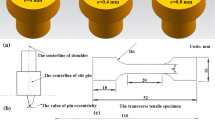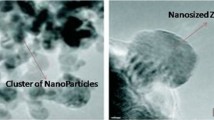Abstract
In friction stir welding, geometrical and motion features of the tool or pin greatly influence the interaction between the tool and workpiece as well as the resulting joint microstructure and mechanical properties. In order to enhance the material flow by optimizing the tool geometrical features, a new strategy was proposed in this study to introduce eccentric motion by offsetting the pin from the tool shoulder, and thin Al–Mg-Si aluminum alloy plates were friction stir welded by varying the pin eccentricity. The material flow and mixing characteristic were analyzed by optical microscope and tracer material method. The grain size and micro-texture of the stir zone were analyzed by electron backscatter diffraction. Uniaxial tensile tests and digital image correlation were conducted to evaluate the mechanical properties and observe the in situ strain evolution. The results show that pin eccentricity has a positive effect on promoting the material flow and grain refinement in the stir zone. The texture intensity was increased as pin eccentricity was introduced, and the dominant texture component converted from C {001} < 110 > (without eccentricity) to \(\mathrm{B}\)/\(\overline{\mathrm{B} }\){112} < 110 > when eccentric pin was used. However, no discerning change can be seen in the thermal history between samples. Despite the variation in softening of the stir zone with eccentricity, the ultimate tensile strength change was negligible. The average ultimate tensile strength reached approximately 198 MPa regardless of the pin eccentricity, and all joints fractured at the heat-affected zone. However, the softened stir zone caused by pin eccentricity resulted in an obvious increase in the joint elongation. It can be concluded that pin eccentricity significantly improved the material flow and grain refinement in the stir zone as well as enhanced the toughness of the weld joint.






















Similar content being viewed by others
References
Marzbanrad J, Akbari M, Asadi P, Safaee S (2014) Characterization of the influence of tool pin profile on microstructural and mechanical properties of friction stir welding. Metall Mater Trans B 45:1887–1894. https://doi.org/10.1007/s11663-014-0089-9
Shen Z, Ding Y, Gerlich AP (2020) Advances in friction stir spot welding. Crit Rev Solid State Mater Sci 45:457–534. https://doi.org/10.1080/10408436.2019.1671799
Shen Z, Liu X, Li D, Ding Y, Hou W, Chen H, Li W, Gerlich AP (2021) Interfacial bonding and mechanical properties of Al/Mg dissimilar refill friction stir spot welds using a grooved tool. Crystals 11:429. https://doi.org/10.3390/cryst11040429
Mao Y, Ke L, Liu F, Liu Q, Huang C, Xing L (2014) Effect of tool pin eccentricity on microstructure and mechanical properties in friction stir welded 7075 aluminum alloy thick plate. Mater Des 62:334–343. https://doi.org/10.1016/j.matdes.2014.05.038
Niu PL, Li WY, Chen DL (2021) Tensile and cyclic deformation response of friction-stir-welded dissimilar aluminum alloy joints: strain localization effect. J Mater Sci Technol 73:91–100. https://doi.org/10.1016/j.jmst.2020.07.045
Hu W, Ma Z, Ji S, Qi S, Chen M, Jiang W (2020) Improving the mechanical property of dissimilar Al/Mg hybrid friction stir welding joint by PIO-ANN. J Mater Sci Technol 53:41–52. https://doi.org/10.1016/j.jmst.2020.01.069
Hou W, Shen Z, Huda N, Oheil M, Shen Y, Jahed H, Gerlich AP (2021) Enhancing metallurgical and mechanical properties of friction stir butt welded joints of Al–Cu via cold sprayed Ni interlayer. Mater Sci Eng A 809:140992. https://doi.org/10.1016/j.msea.2021.140992
Peng G, Hu Y, Dou G, Sun Y, Huan Y, Kang SH, Piao Z (2022) Enhanced mechanical properties of epoxy composites embedded with MF/TiO2 hybrid shell microcapsules containing n-octadecane. J Ind Eng Chem. https://doi.org/10.1016/j.jiec.2022.03.018
Ge Y, Cheng J, Yan C, Zhang B, Zhu S, Xue L, Hong S, Wu Y, Zhang Z, Liang X (2022) Thermally induced microstructure evolution and effects on the corrosion behaviors of AlFeSi metallic glass coatings. Intermetallics 143:107473. https://doi.org/10.1016/j.intermet.2022.107473
Madhu HC, Edachery V, Lijesh KP, Perugu CS, Kailas SV (2020) Fabrication of wear-resistant Ti3AlC2/Al3Ti hybrid aluminum composites by friction stir processing. Metall Mater Trans A 51:4086–4099. https://doi.org/10.1007/s11661-020-05821-1
Thomä M, Wagner G, Straß B, Wolter B, Benfer S, Fürbeth W (2018) Ultrasound enhanced friction stir welding of aluminum and steel: process and properties of EN AW 6061/DC04-Joints. J Mater Sci Technol 34:163–172. https://doi.org/10.1016/j.jmst.2017.10.022
Shen Z, Ding Y, Guo W, Hou W, Liu X, Chen H, Liu F, Li W, Gerlich A (2021) Refill friction stir spot welding Al alloy to copper via pure metallurgical joining mechanism. Chinese J Mech Eng 34:75. https://doi.org/10.1186/s10033-021-00593-0
Liu XC, Sun YF, Fujii H (2017) Clarification of microstructure evolution of aluminum during friction stir welding using liquid CO2 rapid cooling. Mater Des 129:151–163. https://doi.org/10.1016/j.matdes.2017.05.013
Palanivel R, Mathews PK, Murugan N, Dinaharan I (2012) Effect of tool rotational speed and pin profile on microstructure and tensile strength of dissimilar friction stir welded AA5083-H111 and AA6351-T6 aluminum alloys. Mater Des 40:7–16. https://doi.org/10.1016/j.matdes.2012.03.027
Hou W, Shen Y, Huang G, Yan Y, Guo C, Li J (2018) Dissimilar friction stir welding of aluminum alloys adopting a novel dual-pin tool: microstructure evolution and mechanical properties. J Manuf Process 36:613–620. https://doi.org/10.1016/j.jmapro.2018.10.044
Gadakh VS, Adepu K (2013) Heat generation model for taper cylindrical pin profile in FSW. J Mater Res Technol 2:370–375. https://doi.org/10.1016/j.jmrt.2013.10.003
Zhao H, Shen Z, Booth M, Wen J, Fu L, Gerlich AP (2018) Calculation of welding tool pin width for friction stir welding of thin overlapping sheets. Int J Adv Manuf Technol 98:1721–1731. https://doi.org/10.1007/s00170-018-2350-x
Othman NH, Ishak M, Shah LH (2017) Effect of shoulder to pin ratio on magnesium alloy friction stir welding. IOP Conf Ser Mater Sci Eng 238:012008. https://doi.org/10.1088/1757-899X/238/1/012008
Zhao Y-H, Lin S-B, Qu F-X, Wu L (2006) Influence of pin geometry on material flow in friction stir welding process. Mater Sci Technol 22:45–50. https://doi.org/10.1179/174328406X78424
Bagheri B, Abdollahzadeh A, Abbasi M, Kokabi AH (2020) Numerical analysis of vibration effect on friction stir welding by smoothed particle hydrodynamics (SPH). Int J Adv Manuf Technol 110:209–228. https://doi.org/10.1007/s00170-020-05839-0
Qiu-yang Z, Zhen-yu Z, Cong D, Yu L, En L, Sen-bin Y, Zhong-yu P (2022) Mechanical response of single-crystal copper under vibration excitation based on molecular dynamics simulation. J Manuf Process 75:605–616. https://doi.org/10.1016/j.jmapro.2021.11.066
Mypati O, Pavan Kumar P, Iqbal P, Pal SK, Srirangam P (2021) Molecular dynamics simulation of atomic diffusion in friction stir spot welded Al to Cu joints. Mech Adv Mater Struct. https://doi.org/10.1080/15376494.2021.1972188
Chen Y, Wang H, Ding H, Zhao J, Zhang F, Ren Z (2019) Effect of tool pin eccentricity on the microstructure and mechanical properties of friction stir processed Al-6061 alloy. J Mater Eng Perform 28:2845–2852. https://doi.org/10.1007/s11665-019-04025-y
Shah LH, Midawi AR, Walbridge S, Gerlich A (2020) Influence of tool eccentricity on the material flow and microstructural properties of AA6061 aluminum alloy friction stir welds. J Alloys Compd 826:154219. https://doi.org/10.1016/j.jallcom.2020.154219
Bagheri B, Sharifi F, Abbasi M, Abdollahzadeh A (2022) On the role of input welding parameters on the microstructure and mechanical properties of Al6061-T6 alloy during the friction stir welding: experimental and numerical investigation. Proc Inst Mech Eng Part L J Mater Des Appl 236:299–318. https://doi.org/10.1177/14644207211044407
Bagheri B, Abbasi M, Abdolahzadeh A, Kokabi AH (2020) Numerical analysis of cooling and joining speed effects on friction stir welding by smoothed particle hydrodynamics (SPH). Arch Appl Mech 90:2275–2296. https://doi.org/10.1007/s00419-020-01720-4
Guo N, Wang MR, Meng Q, Zhou L, Tang DY (2015) Effect of tool eccentricity on surface periodic banded structures in friction stir welding. IOP Conf Ser Mater Sci Eng 103:012020. https://doi.org/10.1088/1757-899X/103/1/012020
Abbasi M, Abdollahzadeh A, Bagheri B, Ostovari Moghaddam A, Sharifi F, Dadaei M (2021) Study on the effect of the welding environment on the dynamic recrystallization phenomenon and residual stresses during the friction stir welding process of aluminum alloy. Proc Inst Mech Eng Part L J Mater Des Appl 235:1809–1826. https://doi.org/10.1177/14644207211025113
Callister WD, Rethwisch DG (2018) Materials science and engineering: an introduction. Wiley, New York
Chang CI, Lee CJ, Huang JC (2004) Relationship between grain size and Zener-Holloman parameter during friction stir processing in AZ31 Mg alloys. Scr Mater 51:509–514. https://doi.org/10.1016/j.scriptamat.2004.05.043
Barooni O, Abbasi M, Givi M, Bagheri B (2017) New method to improve the microstructure and mechanical properties of joint obtained using FSW. Int J Adv Manuf Technol 93:4371–4378. https://doi.org/10.1007/s00170-017-0810-3
Abdollahzadeh A, Bagheri B, Abassi M, Kokabi AH, Moghaddam AO (2021) Comparison of the weldability of AA6061-T6 joint under different friction stir welding conditions. J Mater Eng Perform 30:1110–1127. https://doi.org/10.1007/s11665-020-05379-4
Field DP, Nelson TW, Hovanski Y, Jata KV (2001) Heterogeneity of crystallographic texture in friction stir welds of aluminum. Metall Mater Trans A 32:2869–2877. https://doi.org/10.1007/s11661-001-1037-2
Wu Y, Kou H, Wu Z, Tang B, Li J (2018) Dynamic recrystallization and texture evolution of Ti-22Al-25Nb alloy during plane-strain compression. J Alloys Compd 749:844–852. https://doi.org/10.1016/j.jallcom.2018.03.372
Pirgazi H, Akbarzadeh A, Petrov R, Sidor J, Kestens L (2008) Texture evolution of AA3003 aluminum alloy sheet produced by accumulative roll bonding. Mater Sci Eng A 492:110–117. https://doi.org/10.1016/j.msea.2008.03.005
Shah LH (2020) Tool eccentricity in thick-plate aluminum alloy friction stir welds. Dissertation, University of Waterloo
Liu XC, Sun YF, Nagira T, Ushioda K, Fujii H (2019) Strain rate dependent micro-texture evolution in friction stir welding of copper. Materialia 6:100302. https://doi.org/10.1016/j.mtla.2019.100302
Fonda RW, Knipling KE (2011) Texture development in friction stir welds. Sci Technol Weld Join 16:288–294. https://doi.org/10.1179/1362171811Y.0000000010
Moghaddam M, Zarei-Hanzaki A, Pishbin MH, Shafieizad AH, Oliveira VB (2016) Characterization of the microstructure, texture and mechanical properties of 7075 aluminum alloy in early stage of severe plastic deformation. Mater Charact 119:137–147. https://doi.org/10.1016/j.matchar.2016.07.026
Huang Y, Meng X, Zhang Y, Cao J, Feng J (2017) Micro friction stir welding of ultra-thin Al-6061 sheets. J Mater Process Technol 250:313–319. https://doi.org/10.1016/j.jmatprotec.2017.07.031
Mehta KP, Badheka VJ (2016) A review on dissimilar friction stir welding of copper to aluminum: process, properties, and variants. Mater Manuf Process 31:233–254. https://doi.org/10.1080/10426914.2015.1025971
Shah LH, Huda N, Esmaeili S, Walbridge S, Gerlich AP (2020) Structural morphology of Al-Mg-Si alloy friction stir welds through tool eccentricity. Mater Lett 275:128098. https://doi.org/10.1016/j.matlet.2020.128098
Ambrosio D, Garnier C, Wagner V, Aldanondo E, Dessein G, Cahuc O (2020) Relationships between welding parameters, aging conditions, and weld properties in AA7075-T6 friction stir welds. Int J Adv Manuf Technol 111:1333–1350. https://doi.org/10.1007/s00170-020-06184-y
Mishra RS, Ma ZY (2005) Friction stir welding and processing. Mater Sci Eng R Reports 50:1–78. https://doi.org/10.1016/j.mser.2005.07.001
Prabu SSM, Madhu HC, Perugu CS, Akash K, Mithun R, Kumar PA, Kailas SV, Anbarasu M, Palani IA (2019) Shape memory effect, temperature distribution and mechanical properties of friction stir welded nitinol. J Alloys Compd 776:334–345. https://doi.org/10.1016/j.jallcom.2018.10.200
dos Santos JF, Staron P, Fischer T, Robson JD, Kostka A, Colegrove P, Wang H, Hilgert J, Bergmann L, Hütsch LL, Huber N, Schreyer A (2018) Understanding precipitate evolution during friction stir welding of Al-Zn-Mg-Cu alloy through in-situ measurement coupled with simulation. Acta Mater 148:163–172. https://doi.org/10.1016/j.actamat.2018.01.020
Funding
This study is financially supported by National Natural Science Foundation of China (NSFC) (52175194, 52105215, 52075047) and Fundamental Research Funds for the Provincial Universities of Zhejiang (Grant No. RF-A2019008).
Author information
Authors and Affiliations
Contributions
All authors contributed to the study conception and design. Material preparation, data collection, and analysis were performed by Wentao Hou and Yuquan Ding. The first draft of the manuscript was written by Wentao Hou, and all authors commented on previous versions of the manuscript. All authors read and approved the final manuscript.
Corresponding authors
Ethics declarations
Competing interests
The authors declare no competing interests.
Additional information
Publisher's Note
Springer Nature remains neutral with regard to jurisdictional claims in published maps and institutional affiliations.
Rights and permissions
About this article
Cite this article
Hou, W., Ding, Y., Huang, G. et al. The role of pin eccentricity in friction stir welding of Al-Mg-Si alloy sheets: microstructural evolution and mechanical properties. Int J Adv Manuf Technol 121, 7661–7675 (2022). https://doi.org/10.1007/s00170-022-09793-x
Received:
Accepted:
Published:
Issue Date:
DOI: https://doi.org/10.1007/s00170-022-09793-x




